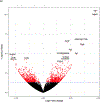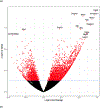Cadmium-mediated pancreatic islet transcriptome changes in mice and cultured mouse islets
- PMID: 34666113
- PMCID: PMC9873403
- DOI: 10.1016/j.taap.2021.115756
Cadmium-mediated pancreatic islet transcriptome changes in mice and cultured mouse islets
Abstract
Type II diabetes mellitus (T2DM) is a multifactorial disease process that is characterized by insulin resistance and impairment of insulin-producing pancreatic islets. There is evidence that environmental exposure to cadmium contributes to the development of T2DM. The presence of cadmium in human islets from the general population and the uptake of cadmium in β-cells have been reported. To identify cadmium-mediated changes in gene expression and molecular regulatory networks in pancreatic islets, we performed next-generation RNA-Sequencing (RNA-Seq) in islets following either in vivo (1 mM CdCl2 in drinking water) or ex-vivo (0.5 μM CdCl2) exposure. Both exposure regiments resulted in islet cadmium concentrations that are comparable to those found in human islets from the general population. 6-week in vivo cadmium exposure upregulates the expression of five genes: Synj2, Gjb1, Rbpjl, Try5 and 5430419D17Rik. Rbpjl is a known regulator of ctrb, a gene associated with diabetes susceptibility. With 18-week in vivo cadmium exposure, we found more comprehensive changes in gene expression profile. Pathway enrichment analysis showed that these secondary changes were clustered to molecular mechanisms related to intracellular protein trafficking to the plasma membrane. In islet culture, cadmium ex vivo significantly induces the expression of Mt1, Sphk1, Nrcam, L3mbtl2, Rnf216 and Itpr1. Mt1 and Itpr1 are known to be involved in glucose homeostasis. Collectively, findings reported here revealed a complex cadmium-mediated effect on pancreatic islet gene expression at environmentally relevant cadmium exposure conditions, providing the basis for further studies into the pathophysiological processes arising from cadmium accumulation in pancreatic islets.
Keywords: Cadmium; Insulin-producing β-cells; Islet transcriptome; Pancreatic islets; Type II diabetes mellitus; mRNA-sequencing.
Copyright © 2021. Published by Elsevier Inc.
Conflict of interest statement
Declaration of competing interest
The authors declare that they have no known competing financial interests or personal relationships that could have appeared to influence the work reported in this paper.
Figures






References
-
- Afridi HI, Kazi TG, Kazi N, Jamali MK, Arain MB, Jalbani N, Baig JA and Sarfraz RA (2008). “Evaluation of Status of Toxic Metals in Biological Samples of Diabetes Mellitus Patients.” Diabetes Research and Clinical Practice 80(2): 280–288. - PubMed
-
- Barregard L, Bergstrom G and Fagerberg B (2013). “Cadmium exposure in relation to insulin production, insulin sensitivity and type 2 diabetes: a cross-sectional and prospective study in women.” Environ Res 121: 104–109. - PubMed
Publication types
MeSH terms
Substances
Grants and funding
LinkOut - more resources
Full Text Sources

